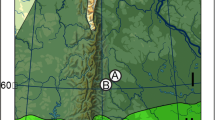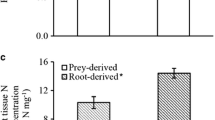Abstract
Termites are dominant organisms of tropical ecosystems. Their success is partly due to the diversity of their feeding substrates, from dead plant tissues to mineralised soils. The Apicotermitinae is one of the richest subfamilies of soil-feeding termites, which are traditionally classified in feeding groups according to anatomical criteria, deemed to the reveal whether species feed on organic-rich layers (group III) or on mineralised soil (group IV). Previous studies based on δ15N isotopic values showed that this subfamily's niche covers a broad range along the gradient of humification. We hypothesised that this broad feeding range could be reflected in the crop-gizzard (Cr-Gi) content and volume. We investigated 17 African species distributed between the two feeding groups. Our results showed a variation of Cr-Gi volume and a consistent composition of content among Apicotermitinae species. Some small-bodied species had a very large Cr-Gi volume relative to their size, indicating a difference in foraging behaviour. These species might use this enhanced storage capacity to forage for longer periods of time. Cr-Gi content was dominated by clay (kaolinite) suggesting that a dietary specialisation could be based on the quality of organic compounds from organo-mineral aggregates. Variations in crystalline solids (quartz) between species indicate either differences in the abundance of mineral grains between feeding patches or active discrimination among particles by foragers. The similar composition of Cr-Gi contents in afrotropical Apicotermitinae suggests that the anatomical criteria used to assign species to feeding groups III or IV are not appropriate.



Similar content being viewed by others
Data accessibility
Measurements for crop-gizzard volume and content are available in Online Resource 3.
References
Benjamini Y, Hochberg Y (1995) Controlling the false discovery rate: a practical and powerful approach to multiple testing. JR Stat Soc B 57:289–300
Bignell DE (1977) Some observations on the distribution of gut flora in the american cockroach, Periplaneta americana. J Invertebr Pathol 29:338–343
Bignell DE (2011) Morphology, physiology, biochemistry and functional design of the termite gut: an evolutionary wonderland. In: Bignell DE, Roisin Y, Lo N (eds) Biology of termites: a modern synthesis. Springer SBM, Dordrecht, pp 375–412
Bignell DE, Eggleton P (1995) On the elevated instestinal pH of higher termites (Isoptera, Termitidae). Insect Soc 42:57–69
Boeckx P, Steppe K, Verbeeck H, Beeckman H, Bogaert J, Defourny P, Dessein S, Verheyen E, Leirs H (2017) Congo basin integrated monitoring for forest carbon mitigation and biodiversity (COBIMFO)—Final Report. Belgian Science Policy, Brussels, p 93
Bottinelli N, Jouquet P, Capowiez Y, Podwojewski P, Grimaldi M, Peng X (2015) Why is the influence of soil macrofauna on soil structure only considered by soil ecologists? Soil Till Res 146:118–124
Bourguignon T, Šobotník J, Lepoint G, Martin JM, Roisin Y (2009) Niche differentiation among neotropical soldierless soil-feeding termites revealed by stable isotope ratios. Soil Biol Biochem 41:2038–2043
Bourguignon T, Šobotník J, Lepoint G, Martin JM, Hardy O, Dejean A, Roisin Y (2011) Feeding ecology and phylogenetic structure of a complex neotropical termite assemblage, revealed by nitrogen stable isotope ratios. Ecol Entomol 36:261–269
Bourguignon T, Drouet T, Šobotník J, Hanus R, Roisin Y (2015a) Influence of soil properties on soldierless termite distribution. PLoS ONE 10(8):e0135341
Bourguignon T, Lo N, Cameron S, Šobotník J, Hayashi Y, Shigenobu S, Watanabe D, Roisin Y, Miura T, Evans TA (2015b) The evolutionary history of termites as inferred from 66 mitochondrial genomes. Mol Biol Evol 32:406–421
Bourguignon T, Šobotník J, Dahlsjö C, Roisin Y (2016) The soldierless Apicotermitinae: insights into a poorly known and ecologically dominant tropical taxon. Insect Soc 63:39–50
Bourguignon T, Lo N, Šobotník J, Ho S, Iqbal N, Coissac É, Lee M, Jendryka M, Sillam-Dussès D, Křížková B, Roisin Y, Evans T (2017) Mitochondrial phylogenomics resolves the global spread of higher termites, ecosystem engineers of the tropics. Mol Biol Evol 34:589–597
Bretz F, Hothorn T, Westfall P (2011) Multiple comparisons using R. Chapman & Hall/ CRC Press, Boca Raton
Brune A, Kühl M (1996) pH profiles of the extremely alkaline hindguts of soil-feeding termites (Isoptera: Termitidae) determined with microelectrodes. J Insect Physiol 42:1121–1127
Brune A, Ohkuma M (2011) Role of the termite gut microbiota in symbiotic digestion. In: Bignell DE, Roisin Y, Lo N (eds) Biology of termites: a modern synthesis. Springer SBM, Dordrecht, pp 413–475
Dahlsjö C, Parr C, Malhi Y, Rahman H, Meir P, Jones DT, Eggleton P (2014) First comparison of quantitative estimates of termite biomass and abundance reveals strong intercontinental differences. J Trop Ecol 30:143–152
Donovan SE, Eggleton P, Bignell DE (2001a) Gut content analysis and a new feeding group classification of termites. Ecol Entomol 26:356–366
Donovan SE, Eggleton P, Dubbin WE, Batchelder M, Dibog L (2001b) The effect of a soil-feeding termite, Cubitermes fungifaber (Isoptera: Termitidae) on soil properties: termites may be an important source of soil microhabitat heterogeneity in tropical forests. Pedobiologia 45:1–11
Dosso K, Konaté S, Aidara D, Linsenmair KE (2010) Termite diversity and abundance across fire-induced habitat variability in a tropical moist savanna (Lamto, central Côte d’Ivoire). J Trop Ecol 26:323–334
Eggleton P (2011) An introduction to termites: biology, taxonomy and functional morphology. In: Bignell DE, Roisin Y, Lo N (eds) Biology of termites: a modern synthesis. Springer SBM, Dordrecht, pp 1–26
Eggleton P, Tayasu I (2001) Feeding groups, lifetypes and the global ecology of termites. Ecol Res 16:941–960
Eggleton P, Bignell DE, Sands WA, Waite B, Wood TG, Lawton JH (1995) The species richness of termites (Isoptera) under differing levels of forest disturbance in the Mbalmayo forest reserve, southern Cameroon. J Trop Ecol 11:85–98
Eggleton P, Bignell DE, Sands WA, Mawdsley NA, Lawton JH, Wood TG, Bignell NC (1996) The diversity, abundance and biomass of termites under differing levels of disturbance in Mbalmayo forest reserve, Southern Cameroon. Phil Trans R Soc Lond B 351:51–68
Eggleton P, Davies RG, Bignell DE (1998) Body size and energy use in termites (Isoptera): the responses of soil feeders and wood feeders differ in a tropical forest assemblage. Oikos 81:525–530
Garnier-Sillam E, Harry M (1995) Distribution of humic compounds in mounds of some soil-feeding termite species of tropical rainforests: its influence on soil structure stability. Insect Soc 42:167–185
Grassé PP (1982) Termitologia. Volume I. Masson, Paris, p 676
Grassé PP, Noirot C (1954) Apicotermes arquieri (Isoptère): ses constructions, sa biologie. Considérations générales sur la sous-famille des Apicotermitinae nov. Ann Sci Nat Zool Biol Anim 16:345–388
Ji R, Brune A (2005) Digestion of peptidic residues in humic substances by an alkali-stable and humic-acid-tolerant proteolytic activity in the gut of soil-feeding termites. Soil Biol Biochem 37:1648–1655
Johnson RA (1979) Configuration of the digestive tube as an aid to identification of worker Termitidae (Isoptera). Syst Entomol 4:31–38
Jouquet P, Bottinelli N, Lata JC, Mora P, Caquineau S (2007) Role of the fungus-growing termite Pseudacanthotermes spiniger (Isoptera, Macrotermitinae) in the dynamic of clay and soil organic matter content. An experimental analysis. Geoderma 139:127–133
Jouquet P, Bottinelli N, Shanbhag R, Bourguignon T, Traoré S, Abbasi SA (2016) Termites: the neglected soil engineers of tropical soils. Soil Sci 181:157–165
Kappler A, Brune A (1999) Influence of gut alkalinity and oxygen status on mobilization and size-class distribution of humic acids in the hindgut of soil-feeding termites. Appl Soil Ecol 13:219–229
Klowden MJ (2013) Physiological systems in insects, 3rd edn. Academic Press, London, p 682
Krishna K, Grimaldi D, Krishna V, Engel M (2013) Treatise on the isoptera of the world. Bull Am Mus Nat Hist 377:1–2704
Madejová J (2003) FTIR techniques in clay mineral studies. Vib Spectrosc 31:1–10
Martin SJ, Funch RR, Hanson PR, Yoo E-H (2018) A vast 4,000-year-old spatial pattern of termite mounds. Curr Biol 28:R1292–R1293
Michels J, Büntzow M (2010) Assessment of Congo red as a fluorescence marker for the exoskeleton of small crustaceans and the cuticle of polychaetes. J Microsc 238:95–101
Misture ST, Snyder RL (2001) X-ray diffraction. In: Buschow KHJ, Cahn RW, Flemings MC, Ilschner B, Kramer EJ, Mahajan S, Veyssière P (eds) Encyclopedia of materials: science and technology. Elsevier, Oxford, pp 9799–9808
Mujinya BB, Mees F, Erens H, Dumon M, Baert G, Boeckx P, Ngongo M, Van Ranst E (2013) Clay composition and properties in termite mounds of the Lubumbashi area, D.R. Congo. Geoderma 192:304–315
Nduwarugira D, Mpawenayo B, Roisin Y (2017) The role of high termitaria in the composition and structure of the termite assemblage in Miombo woodlands of southern Burundi. Insect Conserv Divers 10:120–128
Noirot C (1969) Formation of castes in higher termites. In: Krishna K, Weesner FM (eds) Biology of termites. Academic Press, New York, pp 311–350
Noirot C (1982) La caste des ouvriers, élément majeur du succès évolutif des termites. Riv Biol 75:157–195
Noirot C (2001) The gut of termites (Isoptera): comparative anatomy, systematics, phylogeny. II. Higher termites (Termitidae). Ann Soc Entomol Fr (NS) 37:431–471
Noirot C, Noirot-Timothée C (1969) The digestive system. In: Krishna K, Weesner FM (eds) Biology of termites. Academic Press, New York, pp 49–88
Ohkuma M, Brune A (2011) Diversity, structure, and evolution of the termite gut microbial community. In: Bignell DE, Roisin Y, Lo N (eds) Biology of termites: a modern synthesis. Springer SBM, Dordrecht, pp 413–438
Poorter L, Jans L, Bongers F, Vanrompaey RSAR (1994) Spatial distribution of gaps along three catenas in the moist forest of Taï National Park, Ivory Coast. J Trop Ecol 10:385–398
R Development Core Team (2019) R: a language and environment for statistical computing [Internet]. Viena: R Foundation for Statistical Computing. https://www.r-project.org/. Accessed 13 Mar 2019
Roisin Y, Pasteels JM (1996) The nasute termites (Isoptera, Nasutitermitinae) of Papua New Guinea. Invertebr Taxon 10:507–616
Sands WA (1972) The soldierless termites of Africa (Isoptera: Termitidae). Bull Br Mus Nat Hist (Entomol) 18:1–244
Sands WA (1998) The identification of worker castes of termite genera from soils of Africa and the middle east. CAB International, Cambridge, p 500
Schindelin J, Arganda-Carreras I, Frise E, Kaynig V, Longair M, Pietzsch T, Preibisch S, Rueden C, Saalfeld S, Schmid B, Tinevez JY, White DJ, Hartenstein V, Eliceiri K, Tomancak P, Cardona A (2012) Fiji: an open-source platform for biological-image analysis. Nat Methods 9:676–682
Semhi K, Chaudhuri S, Clauer N, Boeglin JL (2008) Impact of termite activity on soil environment: a perspective from their soluble chemical components. Int J Environ Sci Technol 5:431–444
Sleaford F, Bignell DE, Eggleton P (1996) A pilot analysis of gut contents in termites from the Mbalmayo forest reserve, Cameroon. Ecol Entomol 21:279–288
Tayasu I, Abe T, Eggleton P, Bignell DE (1997) Nitrogen and carbon isotope ratios in termites: an indicator of trophic habit along the gradient from wood-feeding to soil-feeding. Ecol Entomol 22:343–351
Warton DI, Duursma RA, Falster DS, Taskinen S (2012) smatr 3—an R package for estimation and inference about allometric lines. Methods Ecol Evol 3:257–259
Acknowledgements
This work was supported by the Belgian National Fund for Scientific Research F.R.S.-FNRS, PDR T.0065.15 to YR. We thank Pierre Devaif for his help with lighting techniques in microscopy, and Guy Josens for facilitating access to stereomicroscope. We acknowledge the Department 4MAT, Materials Engineering, Characterization, Processing and Recycling at the Université Libre de Bruxelles for their help for XRD and µFTIR measurements. We thank Hugo Darras for his critical input to the manuscript.
Author information
Authors and Affiliations
Corresponding author
Electronic supplementary material
Below is the link to the electronic supplementary material.
Rights and permissions
About this article
Cite this article
Romero Arias, J., Bonneville, S. & Roisin, Y. Crop-gizzard content and volume variations among afrotropical Apicotermitinae (Blattodea, Termitidae). Insect. Soc. 67, 261–271 (2020). https://doi.org/10.1007/s00040-020-00760-x
Received:
Revised:
Accepted:
Published:
Issue Date:
DOI: https://doi.org/10.1007/s00040-020-00760-x




